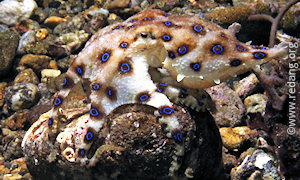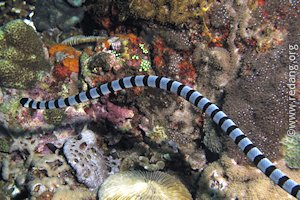 Blue-ringed octopus
Blue-ringed octopus

This golf ball-sized octopus is small, about 7 cm long, shy and hides in coral crevices or under rocks. It may look cute, harmless and attractive but is amongst the most dangerous creatures on the planet. Its venomous bite has claimed a number of human lives as its saliva contains TTX (tetrodotoxin) produced by a bacteria, one of the most potent neurotoxins for which there is no known antidote. TTX is considered to be a hundred times more powerful than potassium cyanide and is also found in certain organs in the pufferfish, porcupinefish, sunfish and a few other animals. The blue rings on its body are only clearly visible and pulsate when the octopus is agitated and about to bite. The bite is slight, reported to be accompanied by little or no pain, but will lead to muscular paralysis and respiratory failure that can lead to death if not treated early. For more information, read Dr. Roy Caldwell's article on blue-ringed octopuses.
 Sea snakes
Sea snakes

Sea snakes are reptiles, have scales and flattened, paddle-like tails with heads that resemble land snakes whereas eels are fishes, have a fish-like face and mouth as well as one long continous dorsal fin. All sea snakes are highly venomous and should not be handled even though they are shy, gentle and do not normally pose a threat unless provoked. When they do bite, venom is injected only in about one-third of all bites. Antidotes are available for treatment. Sea snakes may approach divers or snorkellers out of curiosity. The best defense is to stay calm and not lash out at the snake and it will soon continue on its way. As with other reptiles, they breathe air and have to periodically return to the surface. They are usually found in depths between 5 to 10 metres hunting for food on the seabed or coral reef.




















0 ngomelan mereka..:
Post a Comment